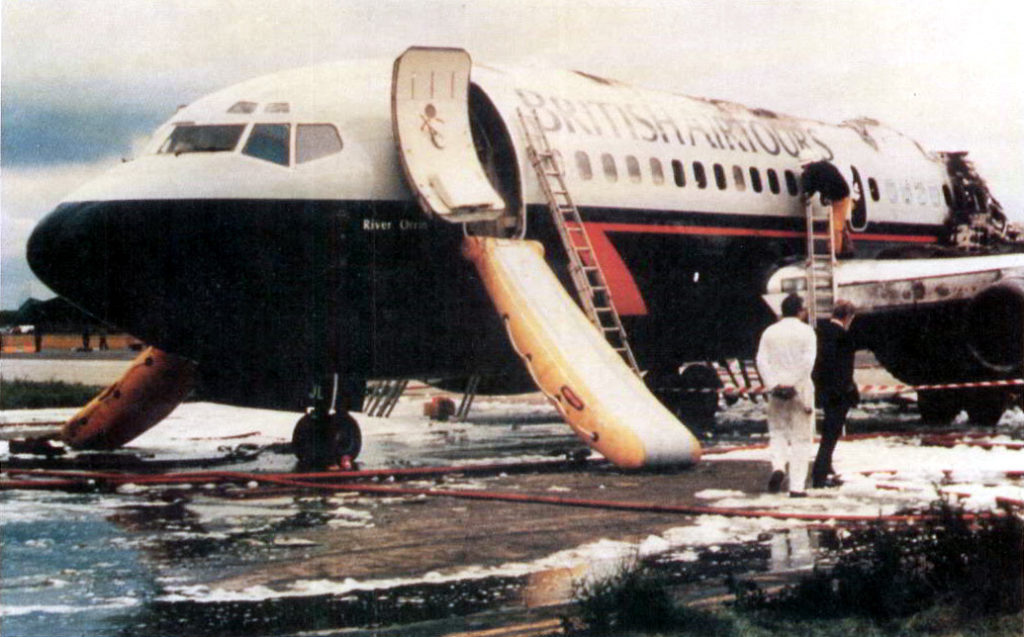Today marks the 32nd anniversary of the Manchester Air Disaster. 55 people died when a 737 burst into flames while taking off from Manchester Airport. We look at the legacy of Flight KT28M 32-years-on.
For most holidaymakers, the 22nd August 1985 started like many other. Looking forward to their holidays they would have arrived at Manchester Airport in jovial spirits ready for their flight to Corfu.
131 passengers and six crew boarded a British Airtours Boeing 737-236 registration G-BGJL. The aircraft was named River Orrin after a famous fishing river in the highlands. Just after 7 am, the aircraft prepared to depart Manchester Airport beginning its takeoff roll on Runway 24.
At 07:13 BST (GMT +1) a loud bang was heard as the aircraft accelerated and the captain, assuming a tyre burst, aborted the takeoff by engaging the thrust reversers and the first officer, who was flying the aircraft, engaged the brakes.
During the aborted takeoff, fire alarms sounded in the cockpit, this coincided with air traffic control stating that “there’s a lot of fire.” and as the aircraft came to a halt turning off the main runway, the controller suggested evacuating passengers from the starboard (right) side as the port (left) engine was well alight. The airport fire service was called although they had already dispatched after seeing the incident for themselves.
The aircraft turned off of runway 24 onto taxiway link Delta and came to a halt and the evacuation began. Unfortunately, by turning this way it put the prevailing wind onto the port side of the aircraft effectively blowing the flames onto the fuselage. This, combined with delays in the evacuation caused by design flaws in the emergency slides, led to fire penetrating the cabin whilst passengers were still onboard the aircraft.
Toxic smoke from burning materials such as seats and fittings filled the cabin resulting in the deaths of 53 passengers and 2 crew, the cause of death was mainly smoke inhalation.
The Air Accident Investigations Branch (AAIB) investigated the accident and concluded that a combustor can on the port engine ruptured, and a section of the can was ejected forcibly into an underwing fuel tank access panel. That panel was fractured, which allowed fuel to spill onto hot combustion gases from the engine. The resulting fire developed catastrophically, primarily due to the orientation of the aircraft and the fire to the wind.
The AAIB went on to say “the major cause of the fatalities was rapid incapacitation due to the inhalation of the dense toxic/irritant smoke atmosphere within the cabin, aggravated by evacuation delays caused by a forward right door malfunction and restricted access to the exits.”
The accident was described as a watershed moment for British aviation.
As a result of the accident, the Cranfield Institute did a large amount of research into the evacuation of aircraft in emergencies and combustible materials.
Their findings led to the redesign of seating around emergency exits and galley areas to aid in a more rapid evacuation along. Materials used in the cabin must now be able to resist fire for significant periods and not give off toxic fumes.
One controversial measure that came from the research was the use of smoke hoods. Overwhelming evidence suggested that smoke hoods would have saved multiple lives in the accident however they were deemed impractical and too expensive to equip across a whole aircraft. Modern aircraft do carry smoke hoods for cabin crew use.
The Air Accident Investigations Branch made a total of 31 safety recommendations as a result of the including:
- In the event of a fire, procedures to be developed to enable the crew to position an aircraft with the fire downwind of the fuselage
- Fire extinguishing techniques inside passengers cabins to be reviewed to deal with internal fires
- Aircraft cabin materials to be fire resistant, including seat covers, wall and ceiling panels
- Onboard water spray/mist fire extinguishing systems to be developed as a matter of urgency
- Experienced cabin crew should be distributed throughout the cabin
In recent years there have been a number of significant engine fires on takeoff, notably a British Airways 777 in Las Vegas in 2015. The port engine of G-VIIO burst into flames on take off and when the aircraft was brought to a halt, fire lapped against the fuselage. All 170 passengers and crew safely evacuated before fire penetrated the cabin and perhaps all of them owe a debt to the work carried out by the Cranfield Institute.
On the 30th anniversary of the Manchester Air Disaster in 2015, both British Airways (British Airtours was part of British Airways) and Manchester Airport apologised to the survivors and victims families. British Airways said the apology was “for their loss” and the “memories they have had to live with over the past 30 years”.

